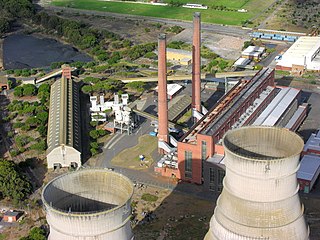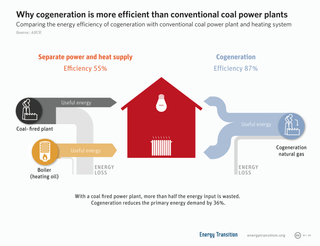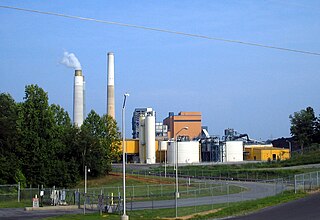
A power station, also referred to as a power plant and sometimes generating station or generating plant, is an industrial facility for the generation of electric power. Power stations are generally connected to an electrical grid.

A combined cycle power plant is an assembly of heat engines that work in tandem from the same source of heat, converting it into mechanical energy. On land, when used to make electricity the most common type is called a combined cycle gas turbine (CCGT) plant. The same principle is also used for marine propulsion, where it is called a combined gas and steam (COGAS) plant. Combining two or more thermodynamic cycles improves overall efficiency, which reduces fuel costs.

Cogeneration or combined heat and power (CHP) is the use of a heat engine or power station to generate electricity and useful heat at the same time.

A thermal power station is a type of power station in which heat energy is converted to electrical energy. In a steam-generating cycle heat is used to boil water in a large pressure vessel to produce high-pressure steam, which drives a steam turbine connected to an electrical generator. The low-pressure exhaust from the turbine enters a steam condenser where it is cooled to produce hot condensate which is recycled to the heating process to generate more high pressure steam. This is known as a Rankine cycle.

The Lakeview Generating Station was an Ontario Power Generation coal-burning station located in Lakeview, a community just east of Port Credit, in Mississauga, Ontario, Canada. The former station, constructed in 1958–1962, was located just east of Lakeshore Road and Cawthra Road. The four stacks of the station were known as the Four Sisters; the eight boilers of the generating plant all 'twinned' their emissions into common stacks. The station was a landmark for years and was shut down in April, 2005, after 43 years of service. The four stacks, which could be seen from as far away as Burlington to the west and downtown Toronto to the east, were demolished on June 12, 2006. The rest of the building was demolished on June 28, 2007.
The Keystone Generating Station is a 1.71-gigawatt, coal power plant located on roughly 1,500 acres (610 ha) in Plumcreek Township, southeastern Armstrong County, Pennsylvania near Crooked Creek, just west of Shelocta, Pennsylvania.

Belews Creek Steam Station is a 2.24-GW, two-unit coal-fired generating facility located on Belews Lake in Stokes County, North Carolina. It is Duke Energy’s largest coal-burning power plant in the Carolinas and consistently ranks among the most efficient coal facilities in the United States. During 2006, it was the fifth most efficient coal power plant in the United States with a heat rate of 9,023 Btu/kWh. The remaining 62.2% of energy released by the burning coal is in the form of heat. It is dumped into Belews Lake, a man-made lake created by Duke Power for cooling water purposes in the early 1970s. In 2008, it was the #1 most efficient coal power plant in the United States with a heat rate of 9,204 British thermal units per kilowatt-hour (2.697 kWh/kWh) or 37.1% conversion efficiency.
The Westinghouse Combustion Turbine Systems Division (CTSD), part of Westinghouse Electric Corporation's Westinghouse Power Generation group, was originally located, along with the Steam Turbine Division (STD), in a major industrial manufacturing complex, referred to as the South Philadelphia Works, in Lester, PA near to the Philadelphia International Airport.

The Newport Power Station was a complex of power stations located on the west bank of the Yarra River, approximately 6 km south-west of Melbourne, Victoria, Australia, in the suburb of Newport. Newport A, B, and C were coal-fired plants which operated at the site between 1919 and the 1980s, and were claimed to be the largest power station in the southern hemisphere in 1953 with 42 boilers and 14 turbo-alternators producing 327 megawatts (439,000 hp).

Kingsnorth power station was a dual-fired coal and oil power station on the Hoo Peninsula at Medway in Kent, South East England. The four-unit station was operated by energy firm E.ON UK, and had a generating capacity of 2,000 megawatts. It was capable of operating on either coal or oil, though in practice oil was used only as a secondary fuel or for startup. It was also capable of co-firing biofuel, up to a maximum of 10% of the station's fuel mix. A replacement power station, also coal-fired, was considered by owners E.ON, but plans were abandoned. The proposed replacement attracted substantial public protests and criticism, including the 2008 Camp for Climate Action.

The Littlebrook Power Station were a series of four oil and coal-fired power stations situated on the south bank of the River Thames, next to the Queen Elizabeth 2 Bridge and the Dartford Tunnel in Dartford, Kent. The final power station, Littlebrook D, ceased operating in March 2015, and has now been demolished.

The New Plymouth Power Station (NPPS) was a 600 MW thermal power station at New Plymouth, New Zealand. Located at Port Taranaki, it was dual fuelled on natural gas and fuel oil. Constructed at a time of major hydro and HV transmission developments, it was New Zealand's first big thermal power station planned for continuous base load operation.

Peterborough Power Station is a 360MW gas-fired power station at Eastern Industry, Fengate in the city of Peterborough, Cambridgeshire in the United Kingdom. It employs around forty people.

Little Barford Power Station is a gas-fired power station just north of the village of Little Barford in Bedfordshire, England. It lies just south of the A428 St Neots bypass and east of the Wyboston Leisure Park. The River Great Ouse runs alongside. It was formerly the site of two coal-fired power stations, now demolished. The station is operated by RWE.

Shoreham Power Station is a 420MWe combined cycle gas-fired power station in Southwick, West Sussex. It was built on the site of the Brighton B Power Station.

Mohave Power Station was a 1580 megawatt electric (MWe) coal-fired power plant that was located in Laughlin, Nevada. Southern California Edison is the majority owner of the plant and was its operator. The plant entered commercial operation in 1971. A steam line that ran near the plant's control room and cafeteria ruptured on June 9, 1985, fatally scalding six and injuring ten more. In 2005, the plant was shut down and was later dismantled.

The West Burton power stations are a pair of power stations on the River Trent near Gainsborough, Lincolnshire, England. West Burton A was a coal-fired power station, which was commissioned in 1966 and operated until 2023, and West Burton B is a combined cycle gas turbine power station, commissioned in 2013. West Burton A was owned and operated by EDF Energy, while West Burton B is owned and operated by EIG Global Energy Partners.
The Ultimo Power Station, or Ultimo Powerhouse, was an electricity generating plant located in the inner-city Sydney suburb of Ultimo, New South Wales. Commissioned in 1899, it was the first major power station in Sydney and was originally built to supply power for the electric tram network. Prior to this, a small installation had existed at Regent Street, which was brought into use on 15 June 1882. Additionally, experimental electric tram operations powered by small generators had been in intermittent use in Sydney since 1890.
Butibori Power Project is a coal-based thermal power plant located at Butibori near Nagpur in the Indian state of Maharashtra. The power plant is operated by the Reliance Power.

Leicester power stations are a series of electricity generating stations that have provided electric power to the City of Leicester and the wider area from 1894. The first station, located within Aylestone gas works, supplied electricity for street lighting. The city’s new electric tram system was supplied from 1904 by a station at Lero which operated until 1930. A large coal-fired power station was constructed at Freemans Meadow in 1922 and was operational until 1976. Finally a gas turbine power plant was commissioned in 1976.
















